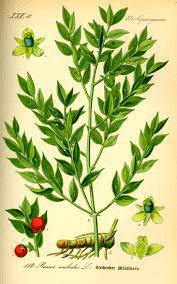Butcher’s Broom (Ruscus aculeatus) is a small evergreen shrub that belongs to the lily family (Asparagaceae). Native to the Mediterranean region, this low-growing, spiny plant is characterized by its tough, flattened stems, which resemble small leaves. The botanical name, Ruscus aculeatus, reflects its spiky nature.
The plant’s common name, “Butcher’s Broom,” is derived from its historical use in Europe, where the stiff stems were bundled together and used as brooms by butchers. Beyond its utilitarian purposes, Butcher’s Broom has also found application in traditional medicine due to its potential health benefits.
One of the key components of Butcher’s Broom is ruscogenins, which are believed to have vasoconstrictive and anti-inflammatory properties. As a result, the plant has been historically used to address circulatory issues and improve blood flow. It is often employed in herbal remedies to alleviate symptoms associated with conditions such as chronic venous insufficiency and varicose veins.
Additionally, Butcher’s Broom has diuretic properties, contributing to its traditional use in promoting kidney and urinary tract health. The plant has also been investigated for its potential anti-inflammatory effects, making it a subject of interest in research exploring natural remedies for inflammatory conditions.
In modern herbal medicine, Butcher’s Broom is available in various forms, including capsules, extracts, and topical creams. Its use is often recommended for individuals seeking support for vascular and circulatory issues.
However, as with any herbal remedy, it’s crucial to consult with healthcare professionals before use, particularly for individuals with pre-existing health conditions or those taking medications.
In landscaping, Butcher’s Broom is valued for its evergreen foliage and adaptability to shade, making it a popular choice for ground cover in gardens. Its unique appearance, with dark green stems and red berries, adds ornamental value to outdoor spaces.
Overall, Butcher’s Broom stands as a versatile plant with historical significance and contemporary applications in both traditional medicine and landscaping.
The Botanical Description of Butcher’s Broom
1. Leaves: Butcher’s Broom (Ruscus aculeatus) is an evergreen shrub with flat, spiky leaves that resemble modified stems. These leaves, known as cladodes, are scale-like and provide a unique appearance to the plant.
2. Height: The shrub typically reaches a height of 2 to 3 feet, forming dense, upright branches. Its growth habit is slow, contributing to its longevity in various environments.
3. Flowers: Small, greenish-white flowers emerge from the center of the cladodes, usually inconspicuous due to the dominant foliage. The flowering period occurs in late winter to early spring.
4. Berries: Following pollination, female plants produce bright red berries, adding a splash of color to the plant. These berries are not only ornamental but also play a role in the reproduction of Butcher’s Broom.
5. Root System: Butcher’s Broom has a rhizomatous root system, with underground stems that spread horizontally. The roots are essential for nutrient absorption and provide stability to the plant.
6. Adaptability: This shrub is well-adapted to various soil types, including sandy and rocky soils. Its ability to thrive in both sun and shade makes it suitable for diverse landscapes.
7. Aroma: Butcher’s Broom is characterized by its lack of aromatic features. Unlike some herbs, it does not emit a distinct fragrance, and its value lies more in its visual appeal.
8. Seasonal Changes: The evergreen nature of Butcher’s Broom ensures that it retains its foliage throughout the year, providing a consistent and appealing presence in gardens and natural settings.
9. Wildlife Interaction: The red berries produced by female plants attract birds, contributing to the ecological interaction and dispersal of seeds.
The Geographic Distribution of Butcher’s Broom
1. Europe: Butcher’s Broom is native to various regions in Europe, including the Mediterranean. Its historical presence in European landscapes has contributed to its familiarity in these areas.
2. North Africa: The plant extends its distribution into North Africa, where it can be found in countries with suitable climates.
3. Western Asia: Butcher’s Broom has a presence in Western Asian countries, adding to its diverse range of habitats.
4. North America: Introduced to North America, Butcher’s Broom has established itself in certain regions, particularly where conditions mimic its native environment.
5. Cultivation Worldwide: Due to its adaptability and ornamental value, Butcher’s Broom is cultivated in various parts of the world, enhancing its global distribution.
6. Shade Tolerance: The plant’s ability to thrive in shaded areas makes it a sought-after ornamental choice for gardens and landscapes.
7. Naturalized Habitats: Butcher’s Broom has successfully naturalized in certain areas beyond its native range, showcasing its resilience.
8. Garden and Woodland Settings: The adaptability of Butcher’s Broom to different environments makes it suitable for both cultivated gardens and natural woodland settings.
The Chemical Composition of Butcher’s Broom
1. Ruscogenins: Butcher’s Broom is rich in ruscogenins, compounds that contribute to its anti-inflammatory and vasoconstrictive properties.
2. Steroidal Saponins: Steroidal saponins, such as neoruscogenin and ruscogenin, are present in Butcher’s Broom and are associated with its medicinal effects.
3. Flavonoids: The plant contains flavonoids, including quercetin and kaempferol, which contribute to its antioxidant properties.
4. Triterpenes: Butcher’s Broom contains triterpenes, such as beta-amyrin and lupeol, with potential anti-inflammatory and immune-modulating effects.
5. Essential Oils: While not as aromatic as some herbs, Butcher’s Broom does contain essential oils, adding to its overall chemical composition.
6. Phenolic Compounds: Phenolic compounds in Butcher’s Broom contribute to its antioxidant and potential anti-cancer properties.
7. Polysaccharides: The presence of polysaccharides adds to the plant’s overall chemical complexity and may have immune-boosting effects.
8. Alkaloids: Certain alkaloids are found in Butcher’s Broom, although their concentrations are not as high as in some other plant species.
9. Minerals: Essential minerals, including potassium and magnesium, are present in Butcher’s Broom, contributing to its nutritional profile.
10. Amino Acids: The plant contains amino acids, the building blocks of proteins, supporting various physiological functions.
11. Vitamin C: Butcher’s Broom is a source of vitamin C, adding to its nutritional value and potential immune-boosting effects.
12. Fiber: The presence of dietary fiber in Butcher’s Broom contributes to its potential digestive health benefits.
Read Also: 18 Medicinal Health Benefits Of Daffodil (Narcissus)
The Medicinal Health Benefits Of Butcher’s Broom (Ruscus aculeatus)

1. Venous Insufficiency: Butcher’s Broom has been traditionally used to address venous insufficiency, promoting better blood circulation in the legs.
2. Hemorrhoid Relief: The vasoconstrictive properties of Butcher’s Broom make it a potential remedy for hemorrhoids, reducing swelling and discomfort.
3. Edema Treatment: The anti-inflammatory effects of Butcher’s Broom may aid in the treatment of edema, reducing fluid retention.
4. Varicose Vein Support: The plant’s ability to strengthen blood vessels may contribute to the management of varicose veins.
5. Anti-Inflammatory Effects: Butcher’s Broom contains compounds with anti-inflammatory properties, potentially beneficial for conditions like arthritis.
6. Diuretic Effects: The diuretic effects of Butcher’s Broom may support kidney function and help in reducing excess fluid.
7. Antioxidant Properties: Flavonoids and phenolic compounds in Butcher’s Broom contribute to its antioxidant effects, protecting cells from oxidative stress.
8. Immune Modulation: Certain compounds in Butcher’s Broom may have immune-modulating effects, supporting overall immune system function.
9. Anti-Cancer Potential: Preliminary studies suggest that Butcher’s Broom may have anti-cancer properties, although more research is needed in this area.
10. Respiratory Health: The plant’s potential anti-inflammatory effects may benefit respiratory health, making it a traditional remedy for conditions like asthma.
11. Menstrual Symptoms: Butcher’s Broom has been used to alleviate symptoms of premenstrual syndrome (PMS) and menstrual discomfort.
12. Digestive Support: The fiber content in Butcher’s Broom may contribute to digestive health, promoting regular bowel movements.
13. Anti-Rheumatic Effects: Traditionally, Butcher’s Broom has been used for its potential anti-rheumatic effects, addressing joint pain and inflammation.
14. Cardiovascular Support: The plant’s impact on blood circulation and venous health may contribute to overall cardiovascular support.
15. Anti-Allergic Effects: Butcher’s Broom may have anti-allergic effects, potentially alleviating symptoms of allergies.
16. Anti-Bacterial Properties: Certain components in Butcher’s Broom may exhibit antibacterial properties, contributing to its overall medicinal profile.
17. Anti-Thrombotic Effects: Studies suggest that Butcher’s Broom may have anti-thrombotic effects, potentially reducing the risk of blood clots.
18. Anti-Aging Properties: The antioxidant content of Butcher’s Broom may contribute to anti-aging effects, protecting the skin from oxidative damage.
19. Joint Health: Compounds in Butcher’s Broom may support joint health, making it a traditional remedy for arthritis.
The Methods of Usage to Achieve the Provided Health Benefits Of Butcher’s Broom (Ruscus aculeatus)
1. Dietary Supplements: Butcher’s Broom is available in various forms, including capsules and tablets, making it convenient for those seeking its health benefits.
2. Herbal Teas: Infusing Butcher’s Broom in hot water to create a tea allows for the extraction of its beneficial compounds, promoting venous health.
3. Tinctures: Tinctures, prepared by extracting Butcher’s Broom in alcohol, offer a concentrated form for medicinal use.
4. Topical Creams: Creams containing Butcher’s Broom extract can be applied topically to address skin conditions or provide localized relief.
5. Poultices: Creating a poultice by crushing Butcher’s Broom leaves and applying them to the skin may provide relief for joint pain and inflammation.
6. Homeopathic Remedies: Some individuals opt for homeopathic preparations of Butcher’s Broom for a more diluted form of its medicinal effects.
7. Culinary Use: While not a common culinary herb, Butcher’s Broom has been used in certain traditional dishes, adding a unique flavor.
8. Aromatherapy: Inhaling the aroma of Butcher’s Broom essential oil may offer a calming effect on the nervous system.
9. Capsules or Tablets: For those who prefer a convenient form, Butcher’s Broom supplements are available in capsule or tablet form.
10. External Compresses: Soaking a cloth in a Butcher’s Broom-infused solution and applying it as a compress may provide localized relief for swelling and discomfort.
The Side Effects Of Using Butcher’s Broom Medicinal Plant
1. Gastrointestinal Discomfort: Some individuals may experience stomach upset or nausea when using Butcher’s Broom, particularly in high doses.
2. Allergic Reactions: Allergic reactions to Butcher’s Broom, though rare, may include skin rashes, itching, or swelling. Discontinue use if such reactions occur.
3. Blood Pressure Effects: Butcher’s Broom may impact blood pressure, and individuals with hypertension should use it with caution.
4. Pregnancy and Breastfeeding: Pregnant and breastfeeding individuals should avoid the use of Butcher’s Broom due to its potential impact on uterine contractions.
5. Kidney Function: Prolonged or excessive use of Butcher’s Broom may impact kidney function, and individuals with kidney issues should exercise caution.
6. Interactions with Medications: Butcher’s Broom may interact with certain medications, including anticoagulants and antihypertensives, so consultation with a healthcare professional is crucial.
7. Neurological Effects: Some individuals may experience neurotoxic effects with high doses of Butcher’s Broom, affecting the nervous system.
8. Essential Oil Ingestion: Ingesting Butcher’s Broom essential oil is not recommended due to its potency and potential toxicity.
9. Respiratory Distress: Individuals with asthma or respiratory conditions should use Butcher’s Broom cautiously, as it may exacerbate respiratory distress.
10. Liver Health: High doses of Butcher’s Broom may impact liver function, and individuals with liver issues should use it with caution.
11. Photosensitivity: Butcher’s Broom may increase the risk of photosensitivity, making individuals more prone to sunburn and skin reactions.
12. Urinary Issues: Some individuals may experience urinary issues with the use of Butcher’s Broom, and monitoring urinary patterns is advisable.
13. Contraindications: Butcher’s Broom is contraindicated in certain conditions, and individuals with pre-existing health issues should seek professional advice before use.
Read Also: Economic Importance and Uses of Hen Eggs
The Scientific Research and Studies of Butcher’s Broom

1. Venous Insufficiency Studies: Scientific research has explored the efficacy of Butcher’s Broom in addressing venous insufficiency, with positive outcomes in improving blood circulation.
2. Anti-Inflammatory Investigations: Studies have investigated the anti-inflammatory effects of Butcher’s Broom, providing insights into its potential for conditions like arthritis.
3. Hemorrhoid Research: Research has examined the use of Butcher’s Broom in alleviating symptoms of hemorrhoids, highlighting its vasoconstrictive properties.
4. Varicose Vein Trials: Clinical trials have explored the impact of Butcher’s Broom on varicose veins, suggesting its potential in promoting venous health.
5. Edema Management Studies: Scientific investigations have focused on Butcher’s Broom’s role in managing edema, shedding light on its diuretic and anti-inflammatory properties.
6. Anti-Cancer Properties: Preliminary research indicates that certain compounds in Butcher’s Broom may possess anti-cancer properties, although further studies are needed to establish its efficacy.
7. Respiratory Health Research: Studies have explored the potential benefits of Butcher’s Broom for respiratory health, particularly in addressing conditions like asthma.
8. Cardiovascular Effects: Research has delved into the cardiovascular effects of Butcher’s Broom, emphasizing its role in supporting blood circulation and overall heart health.
9. Immune Modulation Investigations: Scientific studies have investigated the immune-modulating effects of Butcher’s Broom, suggesting potential contributions to immune system function.
10. Anti-Rheumatic Effects: Historical uses of Butcher’s Broom for rheumatic conditions have prompted research into its potential anti-rheumatic effects, providing insights into its traditional applications.
11. Anti-Allergic Properties: Studies have explored Butcher’s Broom for its potential anti-allergic effects, indicating its possible role in alleviating symptoms associated with allergies.
The Safety Precautions and Recommendations In Using Butcher’s Broom Medicinal Plant
1. Consultation with Healthcare Professionals: Before incorporating Butcher’s Broom into a wellness routine, individuals with pre-existing health conditions or those on medication should consult healthcare professionals for personalized advice.
2. Dosage Guidelines: Adhering to recommended dosage guidelines is crucial to avoid potential side effects or interactions. Excessive use may lead to adverse reactions.
3. Pregnancy and Breastfeeding: Pregnant and breastfeeding individuals should refrain from using Butcher’s Broom due to its potential impact on uterine contractions.
4. Monitoring Blood Pressure: Individuals with hypertension should monitor their blood pressure closely when using Butcher’s Broom, as it may influence blood pressure levels.
5. Kidney Function Monitoring: Prolonged use of Butcher’s Broom may impact kidney function, and individuals with kidney issues should undergo regular monitoring.
6. Interaction with Medications: Butcher’s Broom may interact with certain medications, including anticoagulants and antihypertensives, necessitating caution and healthcare supervision.
7. Essential Oil Use: Ingesting Butcher’s Broom essential oil is not recommended due to its potency. Essential oils should be used externally or through aromatherapy with care.
8. Respiratory Conditions: Individuals with respiratory conditions, such as asthma, should exercise caution when using Butcher’s Broom, as it may exacerbate respiratory distress.
9. Liver Health Monitoring: High doses of Butcher’s Broom may impact liver function, and individuals with liver issues should undergo regular liver health monitoring.
10. Photosensitivity: Butcher’s Broom may increase photosensitivity, and users should take precautions to avoid excessive sun exposure, especially when using it topically.
11. Urinary Monitoring: Some individuals may experience urinary issues with the use of Butcher’s Broom, and monitoring urinary patterns is advisable.
12. Contraindications: Butcher’s Broom is contraindicated in certain conditions, and individuals with pre-existing health issues should seek professional advice before use.
FAQs About Butcher’s Broom Medicinal Plant
1. Is Butcher’s Broom safe for long-term use?
While Butcher’s Broom is generally safe for short-term use, long-term use should be done under healthcare supervision to monitor potential effects on kidney function and blood pressure.
2. Can Butcher’s Broom be used during pregnancy?
Pregnant individuals should avoid Butcher’s Broom due to its potential impact on uterine contractions.
3. Are there specific populations that should avoid Butcher’s Broom?
Individuals with hypertension, kidney issues, liver conditions, and those taking specific medications should exercise caution and consult healthcare professionals.
4. Can Butcher’s Broom be used topically?
Topical use of Butcher’s Broom, such as in creams or poultices, is common for addressing skin conditions or localized discomfort.
5. Does Butcher’s Broom interact with blood-thinning medications?
Butcher’s Broom may interact with anticoagulants, and users on blood-thinning medications should seek medical advice before use.
6. What is the recommended dosage for Butcher’s Broom supplements?
Dosage recommendations may vary, and it’s crucial to follow product instructions or seek guidance from healthcare professionals for proper dosage.
7. Can Butcher’s Broom be used for respiratory conditions like asthma?
While traditionally used for respiratory health, individuals with asthma should use Butcher’s Broom cautiously, as it may exacerbate respiratory distress in some cases.
8. Is Butcher’s Broom safe for children?
Butcher’s Broom is not recommended for children without proper medical guidance, as its effects on developing systems are not well-established.
9. Can Butcher’s Broom be used for joint pain?
Butcher’s Broom has been traditionally used for joint health, but individuals with joint pain should consult healthcare professionals for personalized advice.
10. Can Butcher’s Broom be used in combination with other herbal remedies?
Combining Butcher’s Broom with other herbal remedies should be done with caution, and it’s advisable to seek guidance from healthcare professionals.
11. Can Butcher’s Broom be used for circulatory issues?
The traditional use of Butcher’s Broom for venous issues suggests its potential benefits for circulatory health, but individual responses may vary.
12. Can Butcher’s Broom be taken on an empty stomach?
While Butcher’s Broom can be taken on an empty stomach, some individuals may experience gastrointestinal discomfort, so taking it with food is advisable.
13. Is Butcher’s Broom suitable for individuals with allergies?
While Butcher’s Broom may have anti-allergic properties, individuals with known allergies to the plant or related species should exercise caution.
14. Can Butcher’s Broom be used for skin conditions?
Topical applications of Butcher’s Broom may benefit certain skin conditions, but individuals with skin conditions should seek advice from dermatologists.
15. Can Butcher’s Broom be used during menstruation?
Individuals considering the use of Butcher’s Broom during menstruation should consult healthcare professionals for personalized advice.
16. How long does it take for Butcher’s Broom to show medicinal effects?
The onset of medicinal effects with Butcher’s Broom can vary, and individual responses may differ based on factors such as dosage and frequency of use.
17. Can Butcher’s Broom be taken with food for better absorption?
Taking Butcher’s Broom with food is advisable, as it may help minimize gastrointestinal discomfort and enhance absorption.
Read Also: Everything You Need to Know About Extinction of Animals

